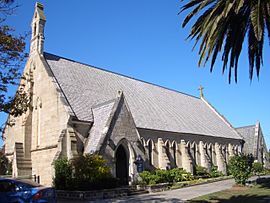St Mary's Anglican Church, Waverley facts for kids
Quick facts for kids St Mary's Anglican Church |
|
|---|---|
| St Mary the Virgin Anglican Church | |
| St Mary's Anglican Church and Pipe Organ | |

St Mary's Anglican Church, Waverley, in 2007
|
|
| 33°53′46″S 151°15′18″E / 33.8962°S 151.2551°E | |
| Location | 240 Birrell Street, Waverley, Waverley Municipality, New South Wales |
| Country | Australia |
| Denomination | Anglican |
| History | |
| Status | Church |
| Founded | 6 June 1863 |
| Founder(s) | Rev. Stanley Mitchell |
| Dedication | Mary, Mother of Jesus |
| Consecrated | 19 May 1864 by Bishop Barker |
| Architecture | |
| Functional status | Active |
| Architect(s) | Edmund Blacket |
| Architectural type | Ecclesiastical Gothic Revival |
| Years built | 1863–1864 |
| Specifications | |
| Materials | Sydney sandstone |
| Administration | |
| Parish | Bondi and Waverley |
| Diocese | Sydney |
| Province | New South Wales |
St Mary's Anglican Church, also known as St Mary the Virgin Anglican Church, is a very old and important church building. It is located in Waverley, a suburb of Sydney, New South Wales, Australia. The church was designed by a famous architect named Edmund Blacket and was built between 1863 and 1864.
This church is special because it has a beautiful pipe organ built by August Gern. The whole church property is owned by the Waverley Anglican Parish. It's so important that it's listed on the New South Wales State Heritage Register, which means it's protected because of its history and beauty.
Contents
About St Mary's Church
A Look Back in Time
How Waverley Got Its Name
The suburb of Waverley got its name from a book! It was named after a novel called Waverley by a famous Scottish writer, Sir Walter Scott. A man named Barnett Levey came to Sydney in the 1820s. He was given a large piece of land in 1831, which is now part of Waverley. He built a big house there in 1827 and called it Waverley House after the book.
Building the Church
Before the current church, there was a smaller stone church built in 1857. But it quickly became too small for the growing community. So, on June 6, 1863, the first stone was laid for the new, bigger church. It was built on land given by T. D. Edwards.
The church was officially opened and blessed on May 19, 1864, by Bishop Barker. It was built by W. Bailey. The original plan included a tall tower, but it was never built. Later, in 1872, porches and a special room for the organ were added. The church was also made longer in the 1870s.
The church was designed in a style called Ecclesiastical Gothic Revival. This style was popular for churches back then. The beautiful stained glass windows in the church are some of the oldest made in New South Wales. In 1888, the special pipe organ was installed.
What Does It Look Like?
The Church Building
St Mary's Church is made of grey sandstone. It has a long main section called a nave, a chancel (the area near the altar), a vestry, and two side porches. The roof is made of concrete tiles, but it was originally made of wooden shingles. The church has tall, narrow windows with pointed tops, which are typical of the Gothic style.
The Grounds and Gardens
The church is built on the highest point in Waverley, so it stands out. It has a strong stone wall along Birrell Street, which was likely built around 1925. There are also old, tall Canary Island date palms and other mature plants that make the gardens look attractive.
The gardens have a formal look with neat lawns and flower beds. On the north side of the church, there's a columbarium (a place for ashes) hidden by a large cypress tree.
Other Buildings
- Hall: The church hall, now used as St. Mary's Child Care Centre, was built around the 1900s. It's made of dark bricks with a tiled roof and has a Gothic style.
- Rectory: There's also a rectory (the house for the church's leader) built around the 1930s.
Why Is It Special?
St Mary's Anglican Church and its pipe organ are very important to New South Wales history and culture. It was added to the New South Wales State Heritage Register on April 2, 1999. Here's why it's considered special:
- Historical Importance: It's one of the oldest buildings in the Waverley area. It shows how the community grew and developed over time.
- Important People: The church is linked to important figures like Bishop Barker and other local families who played a big part in the area's history.
- Beautiful Design: The church is admired for its design by Edmund Blacket. Its location on the highest point in Waverley also makes it a beautiful landmark.
- Community Value: It has been a significant place for the community for social, cultural, and spiritual reasons for many years.
- Rarity: Because of its age, design, and how well it has been kept, it's considered a rare and valuable example of its kind.
- Good Example: It's a great example of a Gothic Revival church designed by Edmund Blacket, showing the typical features of this architectural style.


